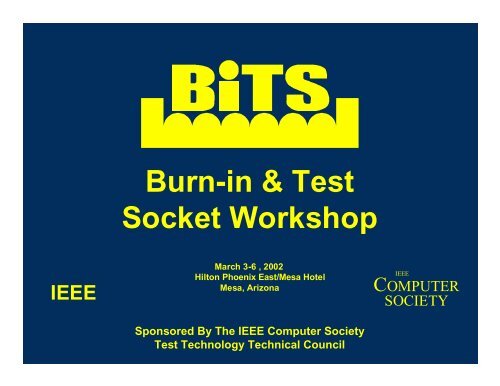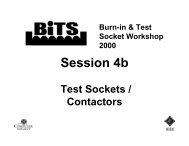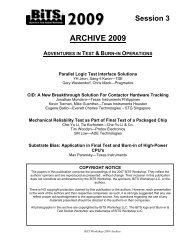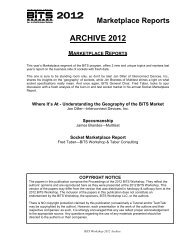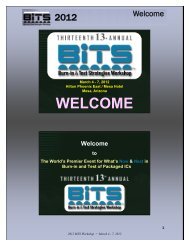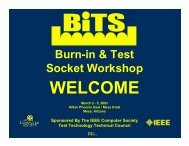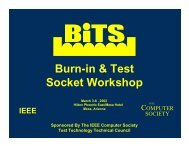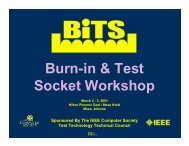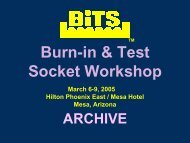Burn-in & Test Socket Workshop - BiTS Workshop
Burn-in & Test Socket Workshop - BiTS Workshop
Burn-in & Test Socket Workshop - BiTS Workshop
Create successful ePaper yourself
Turn your PDF publications into a flip-book with our unique Google optimized e-Paper software.
<strong>Burn</strong>-<strong>in</strong> & <strong>Test</strong><br />
<strong>Socket</strong> <strong>Workshop</strong><br />
IEEE<br />
March 3-6 , 2002<br />
Hilton Phoenix East/Mesa Hotel<br />
Mesa, Arizona<br />
IEEE<br />
COMPUTER<br />
SOCIETY<br />
Sponsored By The IEEE Computer Society<br />
<strong>Test</strong> Technology Technical Council
COPYRIGHT NOTICE<br />
• The papers <strong>in</strong> this publication comprise the proceed<strong>in</strong>gs of the 2002<br />
<strong>BiTS</strong> <strong>Workshop</strong>. They reflect the authors’ op<strong>in</strong>ions and are reproduced as<br />
presented , without change. Their <strong>in</strong>clusion <strong>in</strong> this publication does not<br />
constitute an endorsement by the <strong>BiTS</strong> <strong>Workshop</strong>, the sponsors, or the<br />
Institute of Electrical and Electronic Eng<strong>in</strong>eers, Inc.<br />
· There is NO copyright protection claimed by this publication. However,<br />
each presentation is the work of the authors and their respective<br />
companies: as such, proper acknowledgement should be made to the<br />
appropriate source. Any questions regard<strong>in</strong>g the use of any materials<br />
presented should be directed to the author/s or their companies.
<strong>Burn</strong>-<strong>in</strong> & <strong>Test</strong> <strong>Socket</strong><br />
<strong>Workshop</strong><br />
Technical Program<br />
Session 7<br />
Wednesday 3/06/02 8:00AM<br />
<strong>Burn</strong>-<strong>in</strong> Board Design<br />
“<strong>Burn</strong>-<strong>in</strong> Board Over-current Protection – What Are The Options?”<br />
KW Low - Intel Corporation<br />
Zamel Jaafar - Intel Corporation<br />
“Protect<strong>in</strong>g Conductor Pads On <strong>Burn</strong>-<strong>in</strong> Boards From Oxidation And<br />
Corrosion”<br />
Alfred Sugarman - Loranger International Corporation<br />
Al Loranger - Loranger International Corporation<br />
“Power Decoupl<strong>in</strong>g Optimizer – A Systematic Frequency Doma<strong>in</strong> Approach To<br />
BiB Noise Decoupl<strong>in</strong>g Simulation”<br />
Isaac Chang - Intel Corporation
<strong>Burn</strong>-<strong>in</strong> Board<br />
Over-current Circuit Protection<br />
- What Are The Options?<br />
KW Low/Zamel Jaafar<br />
Intel Malaysia<br />
2002 <strong>Burn</strong>-<strong>in</strong> and <strong>Test</strong> <strong>Socket</strong> <strong>Workshop</strong><br />
March 3 - 6, 2002
Agenda<br />
• Introduction<br />
• UUT Switch<strong>in</strong>g Characteristics<br />
• BIB Over-current Circuit Protective Devices<br />
• Manufactur<strong>in</strong>g Issues & Concerns<br />
• Solutions Investigated<br />
• Technology Challenges<br />
• Conclusion<br />
• Acknowledgement<br />
KWLow/Zamel <strong>BiTS</strong> 2002 2
Introduction<br />
• BIB over-current protection prevents premature<br />
component failures, short circuits and fire hazards.<br />
• In dynamic burn-<strong>in</strong>, current spikes occur at oven power<br />
supplies sequenc<strong>in</strong>g and auto signal checks.<br />
• Common phenomenon for high current, high speed units<br />
under test.<br />
• Fuses are effectively be<strong>in</strong>g utilized for overload or shortcircuit<br />
protection.<br />
• Incidences of nuisance fuse blow<strong>in</strong>g is disruptive to<br />
production.<br />
• Fuse replacement is an expensive & <strong>in</strong>convenient task.<br />
• Number of fuses on a burn-<strong>in</strong> board vary with each design.<br />
• Other better alternatives (technology) are be<strong>in</strong>g reviewed.<br />
KWLow/Zamel <strong>BiTS</strong> 2002 3
UUT Switch<strong>in</strong>g Characteristics(1)<br />
Power-up<br />
current spike<br />
• Dur<strong>in</strong>g oven power sequenc<strong>in</strong>g there are current spikes on the BIB.<br />
• These transients are harmful to the electronic circuit on the BIB and UUT.<br />
• They last for tens of milliseconds and can reach hundreds of millivolts.<br />
KWLow/Zamel <strong>BiTS</strong> 2002 4
UUT Switch<strong>in</strong>g Characteristics(.2)<br />
Fuse limit @ 25C<br />
I max<br />
Nom<strong>in</strong>al fuse rat<strong>in</strong>g<br />
15A<br />
Signal check<br />
pattern start-up<br />
current spike<br />
Average current<br />
Ref<br />
Duration<br />
• Dur<strong>in</strong>g signal check pattern test<strong>in</strong>g current spikes are observed.<br />
• Repetitive high current <strong>in</strong> amperes; hundreds of microseconds <strong>in</strong><br />
duration.<br />
• These current spikes can breach limit of the fuse rat<strong>in</strong>g.<br />
KWLow/Zamel <strong>BiTS</strong> 2002 5
UUT Switch<strong>in</strong>g Characteristics(.3)<br />
Trigger<br />
BI monitor for full pattern length<br />
Current spikes<br />
<strong>in</strong>crease dur<strong>in</strong>g<br />
BIST & Reset<br />
Icc<br />
Idd<br />
• Dur<strong>in</strong>g logic switch<strong>in</strong>g more current spikes are further evident.<br />
• The magnitude and occurrence depends on number of power supplies &<br />
complexity of the stress pattern.<br />
KWLow/Zamel <strong>BiTS</strong> 2002 6
BIB Over-current Protective Device (1)<br />
• Fuses are commonly used to isolate and protect the UUT on BIB.<br />
• Us<strong>in</strong>g correct fuse current rat<strong>in</strong>g, type (fast or slow-act<strong>in</strong>g) and derat<strong>in</strong>g<br />
factor is important to avoid circuit electrical over-stress.<br />
Fuse rat<strong>in</strong>g = Normal Operat<strong>in</strong>g Current/0.75 x % rat<strong>in</strong>g<br />
<strong>Burn</strong>t Trace<br />
Operat<strong>in</strong>g Temp vs Fuse Rat<strong>in</strong>g<br />
% Rat<strong>in</strong>g<br />
180<br />
160<br />
140<br />
120<br />
100<br />
80<br />
60<br />
40<br />
20<br />
0<br />
Slow-Act<strong>in</strong>g<br />
Fast-Act<strong>in</strong>g<br />
PPTC<br />
Lack of protection causes die EOS<br />
-60C<br />
-40C<br />
-20C<br />
0C<br />
20C<br />
25C<br />
40C<br />
60C<br />
Operat<strong>in</strong>g Temp<br />
80C<br />
100C<br />
120C<br />
Fuse value is derated with elevated operat<strong>in</strong>g temperature<br />
• They are current sensitive devices serv<strong>in</strong>g as a weak l<strong>in</strong>k <strong>in</strong> BIB circuit.<br />
• Fuse characteristic is determ<strong>in</strong>ed by respond to various current overload.<br />
• Slow-act<strong>in</strong>g fuse has more thermal <strong>in</strong>ertia that tolerates <strong>in</strong>itial overload<br />
current.<br />
• Fast-act<strong>in</strong>g or very fast-act<strong>in</strong>g fuse is good for sensitive, critical circuits.<br />
KWLow/Zamel <strong>BiTS</strong> 2002 7
BIB Over-current Protective Device (.2)<br />
• Selection of circuit protective devices depends on<br />
- match<strong>in</strong>g circuit characteristic to device specification<br />
- operat<strong>in</strong>g current, voltage and temperature<br />
- required protection device response time<br />
- <strong>in</strong>terrupt rat<strong>in</strong>g<br />
- fault current and<br />
- circuit resistance<br />
• <strong>Burn</strong>-<strong>in</strong> board circuit protection choice.<br />
- Wire Fuse<br />
low power consumption<br />
no leakage current<br />
suitable for high voltage & high current circuits<br />
one time use only<br />
consumable item<br />
high ma<strong>in</strong>tenance cost<br />
Subm<strong>in</strong>iature fuse mounted <strong>in</strong>to turrets<br />
Subm<strong>in</strong>iature fuse soldered onto fork connectors<br />
Subm<strong>in</strong>iature SMD fuses <strong>in</strong> receptacles<br />
KWLow/Zamel <strong>BiTS</strong> 2002 8
Manufactur<strong>in</strong>g Issues & Concern<br />
• Resources are needed to detect, identify and repair burn-<strong>in</strong> boards<br />
with blown fuses.<br />
Short circuit on BIB<br />
- F<strong>in</strong>ance (money)<br />
- Headcount (labour)<br />
- Facility (equipment set-up)<br />
• <strong>Burn</strong>-<strong>in</strong> board ma<strong>in</strong>tenance cost has escalated.<br />
- Labour and component <strong>in</strong>crease<br />
Components & BIB <strong>Burn</strong>t<br />
- Need to manage component <strong>in</strong>ventory<br />
• Extra capacity baked <strong>in</strong>to build plan to offset burn-<strong>in</strong> boards<br />
temporarily taken out of service.<br />
- More burn-<strong>in</strong> board <strong>in</strong>ventory (spares buffer)<br />
- Long through-put-time for product builds (bottleneck)<br />
- Output yields are affected (need to build more <strong>in</strong> advance)<br />
• Good UUTs could be scrapped when they are processed on a burn<strong>in</strong><br />
board with blown fuses.<br />
KWLow/Zamel <strong>BiTS</strong> 2002 9
Solutions Investigated<br />
• Polymer-based Positive Temperature Coefficient (PPTC)<br />
fuse.<br />
resettable<br />
low power consumption<br />
small footpr<strong>in</strong>t<br />
resistance is higher than wire fuse<br />
max operat<strong>in</strong>g temperature ~85 deg C<br />
max operat<strong>in</strong>g current ~11A<br />
PPTC Resettable fuse<br />
• Current-limit<strong>in</strong>g IC.<br />
resettable<br />
feedback signal for closed loop control<br />
fast response<br />
high cost<br />
sensitive to voltage fluctuation<br />
susceptible to program <strong>in</strong>terference<br />
Custom Current-limit<strong>in</strong>g IC<br />
KWLow/Zamel <strong>BiTS</strong> 2002 10
Technology Challenges<br />
• BIB application of resettable fuse depends on:<br />
- Ability to operate at 125 deg C; 45 to 95 deg C typical range<br />
- Little or no leakage current<br />
- Voltage rat<strong>in</strong>g < 5 volts; current rat<strong>in</strong>g 5A, 10A, 15A & 20A<br />
- Small footpr<strong>in</strong>t, preferably SMD<br />
- Low cold resistance<br />
- Improved time-current characteristic (speed of response) better<br />
than for slow blow fuse<br />
• Other solution of us<strong>in</strong>g ICs are still be<strong>in</strong>g reviewed.<br />
- Requires additional circuit to sense and switch<br />
- Software has to be developed to complement circuit function<br />
- Takes up space and reduces socket density on BIB<br />
- More trace rout<strong>in</strong>g makes BIB design complex<br />
- Initial cost is higher<br />
KWLow/Zamel <strong>BiTS</strong> 2002 11
Conclusion<br />
• <strong>Burn</strong>-<strong>in</strong> board is designed with different fuse configuration.<br />
– Fuse per burn-<strong>in</strong> board<br />
- Fuse per socket<br />
- Fuse per socket cluster<br />
- Fuse per socket row<br />
• Need for more user friendly circuit protective devices.<br />
- A better option to wire fuse<br />
- Someth<strong>in</strong>g simple with m<strong>in</strong>imum board re-design<br />
- It has to be a cost effective solution<br />
- Ideally ma<strong>in</strong>tenance free<br />
• As burn-<strong>in</strong> ambient temperature is decreas<strong>in</strong>g, resettable<br />
fuse provides an attractive alternative.<br />
• <strong>Burn</strong>-<strong>in</strong> board is a multimillion $$$ bus<strong>in</strong>ess, any viable<br />
option has a ready market.<br />
KWLow/Zamel <strong>BiTS</strong> 2002 12
Acknowledgement<br />
The authors would like to acknowledge the support<br />
provided by colleagues for their comments &<br />
suggestions <strong>in</strong> the preparation of this presentation:<br />
Anthony Wong, CS Low, HL Kon, KH Lee, KS Yeoh<br />
&<br />
P Schubr<strong>in</strong>g<br />
Thank You<br />
KWLow/Zamel <strong>BiTS</strong> 2002 13
PROTECTING CONDUCTOR<br />
PADS ON BURN-IN BOARDS<br />
FROM OXIDATION AND<br />
CORROSION<br />
by Alfred Sugarman, Al Loranger<br />
Presented at<br />
<strong>BiTS</strong> <strong>Burn</strong>-In & <strong>Test</strong> <strong>Socket</strong> <strong>Workshop</strong><br />
March 3-6, 2002<br />
Mesa, AZ
PURPOSE<br />
Evaluate different conductor pad coat<strong>in</strong>gs<br />
on burn-<strong>in</strong> boards for contact stability and<br />
resistance.<br />
Slide 2
PROCEDURE<br />
• Pr<strong>in</strong>ted circuit assemblies (PCAs) for test<strong>in</strong>g a Loranger LGA<br />
375SQ312L6617 socket were fabricated with the follow<strong>in</strong>g conductor<br />
pad coat<strong>in</strong>gs.<br />
COATING THICKNESSES ON TESTED BOARDS<br />
- 20 µ<strong>in</strong> Electroplated Gold - bare copper<br />
- 50 µ<strong>in</strong> Electroplated Gold - 100 µ<strong>in</strong> Electroplated Nickel<br />
- 300 µ<strong>in</strong> Solder<br />
• Coat<strong>in</strong>g thicknesses on conductor pads of the PCAs were<br />
<strong>in</strong>dependently measured to confirm the nom<strong>in</strong>al values above.<br />
• Electrical resistances and average contact deflections were measured<br />
<strong>in</strong> the sockets at 0 hours and at <strong>in</strong>crements of time throughout the<br />
burn-<strong>in</strong> process. Resistances were measured by us<strong>in</strong>g a gold plated<br />
mock device. The mock device nulled any effect of plat<strong>in</strong>g and/or<br />
coat<strong>in</strong>gs on the package to isolate the data to the burn-<strong>in</strong> board<br />
conductor pad plat<strong>in</strong>g only.<br />
Slide 3
Procedure Cont<strong>in</strong>ued<br />
• PCAs were assembled with sockets and heated to 125ºC for<br />
<strong>in</strong>crements of time up to 1,000 hours to simulate burn-<strong>in</strong><br />
process.<br />
• Periodically the PCAs were removed from the oven to measure<br />
contact resistances and exam<strong>in</strong>e the conductor pads.<br />
• Gold coated boards were cleaned after 1,000 hours burn-<strong>in</strong> by<br />
first swabb<strong>in</strong>g conduct<strong>in</strong>g pads with isopropyl alcohol and then<br />
clean<strong>in</strong>g them <strong>in</strong> a dishwasher with ord<strong>in</strong>arily dishwasher<br />
detergent.<br />
• Contact resistance with contact deflection was evaluated by<br />
stack<strong>in</strong>g.0038” paper shims on top of the mock device and<br />
clos<strong>in</strong>g the cover.<br />
Slide 4
Figure 1. Typical MAP6 board on which sockets were burned <strong>in</strong> and resistances<br />
measured.<br />
Slide 5
Resistance Change, Ohms<br />
Contact Resistance For Gold Plated Conductor<br />
Pads<br />
0.25<br />
0.20<br />
0.15<br />
0.10<br />
0.05<br />
0.00<br />
-0.05<br />
-0.10<br />
-0.15<br />
-0.20<br />
-0.25<br />
50µ<strong>in</strong> Gold<br />
20µ<strong>in</strong> Gold<br />
1 10 100 1,000<br />
Hours <strong>Burn</strong>ed In<br />
Slide 6
Contact Resistance For Solder Coated Conductor Pads<br />
1.40<br />
Resistance Change, Ohms<br />
1.20<br />
1.00<br />
0.80<br />
0.60<br />
0.40<br />
0.20<br />
0.00<br />
-0.20<br />
1 10 100 1,000<br />
Hours <strong>Burn</strong>ed In<br />
Slide 7
Resistance Change, Ohms<br />
8.00<br />
7.00<br />
6.00<br />
5.00<br />
4.00<br />
3.00<br />
2.00<br />
1.00<br />
0.00<br />
Contact Resistance For Bare Copper<br />
Conductor Pads<br />
1 10 100 1,000<br />
Hours <strong>Burn</strong>ed In<br />
Slide 8
Resistance Change, Ohms<br />
Contact Resistance For All Conductor Pads<br />
8.00<br />
7.00<br />
50µ<strong>in</strong> Gold<br />
20µ<strong>in</strong> Gold<br />
6.00<br />
Bare Copper<br />
5.00<br />
100 µ<strong>in</strong> Nickel<br />
4.00<br />
300 µ<strong>in</strong> Solder<br />
Bare Copper<br />
3.00<br />
2.00<br />
1.00<br />
0.00<br />
-1.00 1 10 100 1,000<br />
Hours <strong>Burn</strong>ed In<br />
Slide 9
0.000<br />
Reduction In Contact Resistance With<br />
Deflection<br />
-0.050<br />
0.000 0.005 0.010 0.015 0.020 0.025 0.030<br />
Reduction In Contact<br />
Resistance (Ohms)<br />
-0.100<br />
-0.150<br />
-0.200<br />
-0.250<br />
-0.300<br />
-0.350<br />
50µ<strong>in</strong> Gold<br />
20µ<strong>in</strong> Gold<br />
Contact Deflection (<strong>in</strong>ches)<br />
Improv<strong>in</strong>g<br />
Slide 10
TABLE 1. NUMBER OF OPEN CONTACTS AFTER<br />
BURN-IN AT 125ºC<br />
Hours <strong>Burn</strong>-In 1 6 12 24 48 100 250 500 1,000<br />
50µ<strong>in</strong> Gold 0 0 0 0 0 0 0 0 0<br />
20µ<strong>in</strong> Gold 0 0 0 0 0 0 0 0 0<br />
300 µ<strong>in</strong> Solder 0 0 0 0 0 0 0 4 24<br />
100 µ<strong>in</strong> Nickel 0 1 2 0 0 0 0 0 0<br />
Bare Copper 0 2 0 0 6 3 15 27 65<br />
Slide 11
Figure 2. 50 µ<strong>in</strong> thick gold plated<br />
conductor pads after 500 hrs at 125<br />
ºC. This is typical of appearance of<br />
similar conductor pads.<br />
Figure 3. 50 µ<strong>in</strong> thick gold plated<br />
conductor pads after 1,000 hrs at<br />
125 ºC. Note good uniform<br />
appearance.<br />
Figure 4. 20 µ<strong>in</strong> thick electroless gold<br />
plated conductor pads after 1,000 hrs at<br />
125 ºC. Note blister<strong>in</strong>g.<br />
Slide 12
Figure 5. 300 µ<strong>in</strong> thick solder<br />
plated conductor pads after 1,000<br />
hrs at 125 ºC. Note 5 mil deep<br />
witness marks left <strong>in</strong> the solder.<br />
Figure 6. 100 µ<strong>in</strong> nickel plated<br />
conductor pad after 1,000 hours at<br />
125ºC.<br />
Figure 7. Bare copper conductor pad<br />
after 1,000 hours at 125 ºC.<br />
Slide 13
REVIEW OF GOLD COATING THICKNESS<br />
REQUIREMENTS<br />
• IPC-6012A, “Qualification and Performance Specification for Rigid<br />
Pr<strong>in</strong>ted Boards”, Table 3-2<br />
Table 3-2 (partial) F<strong>in</strong>al F<strong>in</strong>ish, Surface Plat<strong>in</strong>g Coat<strong>in</strong>g Requirements<br />
F<strong>in</strong>ish<br />
Class 1 (General<br />
Electronic Products)<br />
Class 2 (Dedicated<br />
Electronic<br />
Products)<br />
Class 3 (High<br />
Reliability<br />
Electronic<br />
Products)<br />
Gold (m<strong>in</strong>) for edge-board<br />
connectors and area not<br />
to be soldered<br />
0.8 µm (30 µ<strong>in</strong>) 0.8 µm (30 µ<strong>in</strong>) 1.25 µm (49 µ<strong>in</strong>)<br />
Slide 14
Gold Coat<strong>in</strong>g Thickness Requirement (cont<strong>in</strong>ued)<br />
•EIA – 540 GAAA, “Detail Specification for <strong>Burn</strong>-In<br />
<strong>Socket</strong>s for Chip Carrier Packages with Molded Carrier<br />
R<strong>in</strong>gs for Use <strong>in</strong> Electronic Equipment”, October 1993.<br />
Paragraph 2.2.9 says .......<br />
2.2.9 CONTACT FINISH AT TERMINATION AREA<br />
Contact f<strong>in</strong>ish at the term<strong>in</strong>ation area shall be designated<br />
by one letter as follows:<br />
K:Gold over Nickel<br />
0.76 micron (30µ”) m<strong>in</strong>. gold over<br />
1.27 microns (50µ”) m<strong>in</strong>. to 3.81<br />
microns (150µ”) max. nickel.<br />
Slide 15
DISCUSSION<br />
• Gold coated conductor pads particularly those with 50 µ<strong>in</strong> gold<br />
had 0 opens and the conductor pads had best appearance.<br />
• Initial resistance and resistance <strong>in</strong>crease with burn-<strong>in</strong> time was<br />
smallest with gold coated conductor pads compared with pads<br />
coated with nickel, solder and bare copper conductor pads.<br />
• Conductor pad coat<strong>in</strong>gs of nickel and solder had larger<br />
<strong>in</strong>creases <strong>in</strong> resistance. Bare copper conductor pads had<br />
largest resistance <strong>in</strong>crease with burn-<strong>in</strong> time<br />
Slide 16
Discussion (cont<strong>in</strong>ued)<br />
• Conductor pads coated with 100 µ<strong>in</strong> nickel and 300 µ<strong>in</strong> solder<br />
and with bare copper had poor electrical stability compared with<br />
gold coated conductor pads.<br />
• Increas<strong>in</strong>g deflection of contacts significantly reduces contact<br />
resistance by <strong>in</strong>creas<strong>in</strong>g contact force and can more than<br />
compensate for <strong>in</strong>creas<strong>in</strong>g resistance with burn-<strong>in</strong> time.<br />
Slide 17
(Discussion Cont<strong>in</strong>ued)<br />
• Reasons for high resistances and low stability <strong>in</strong> other than<br />
gold coated conductor<br />
pads are ...<br />
- Copper and nickel Relatively hard oxide coat<strong>in</strong>g on<br />
coated pads surface of pads<br />
- Solder coated pads Creep of contact through solder<br />
until it touches parent conductor<br />
pad metal.<br />
Slide 18
CONCLUSIONS<br />
• Gold coated conductor pads performed better than all others<br />
to achieve lowest contact resistance and most stability<br />
• Increas<strong>in</strong>g contact deflection (equivalent to <strong>in</strong>creas<strong>in</strong>g force)<br />
made significant reductions <strong>in</strong> contact resistance more than<br />
compensat<strong>in</strong>g for the <strong>in</strong>crease <strong>in</strong> resistance with burn-<strong>in</strong><br />
time<br />
Slide 19
Power Decoupl<strong>in</strong>g<br />
Optimizer – A Systematic<br />
Frequency Doma<strong>in</strong><br />
Approach to BIB Noise<br />
Decoupl<strong>in</strong>g Simulation<br />
Isaac Chang<br />
Intel Corporation<br />
2002 <strong>Burn</strong>-<strong>in</strong> and <strong>Test</strong> <strong>Socket</strong><br />
<strong>Workshop</strong><br />
March 3 - 6, 2002
Agenda<br />
– Understand BIB Power Decoupl<strong>in</strong>g(PD)<br />
– Introduction<br />
– Exist<strong>in</strong>g PD Approach & Drawbacks<br />
– New PD Optimization(PDO) BKM(Best Known Method)<br />
– PDO Uses Ztarget<br />
– Cres Effect <strong>in</strong> Optimization<br />
– PDO – Cbulk/Clocal Optimization Steps<br />
– Capacitor Selection for Cbulk/local<br />
– Example: BIB Capacitor Optimization<br />
– Key Results<br />
– Conclusion<br />
– Acknowledgement<br />
02/01/2002 <strong>BiTS</strong> 2002 2
Understand BIB PD<br />
Instant Supply<br />
PS<br />
Bulk<br />
Local<br />
<strong>Socket</strong><br />
Short Cold Shower<br />
Die<br />
Cold For A While<br />
– When the die consumes a large current <strong>in</strong> a very short<br />
period dur<strong>in</strong>g the output state transition, it will cause<br />
unwanted voltage drop(spikes/transient) along the<br />
power path.<br />
– Thus, the decoupl<strong>in</strong>g capacitors(bulk/local) are placed<br />
near to the die to lower the ground bounce/transient<br />
noise on the power supply(PS) for the device.<br />
• They will charge up dur<strong>in</strong>g the less stressful period and then<br />
provide additional charges dur<strong>in</strong>g the transient <strong>in</strong>stead of the<br />
PS, thus reduc<strong>in</strong>g the spike magnitude along the power path.<br />
02/01/2002 <strong>BiTS</strong> 2002 3
Introduction<br />
• Exist<strong>in</strong>g Time Doma<strong>in</strong>(TD) methodology of<br />
power noise decoupl<strong>in</strong>g is critical for<br />
ensur<strong>in</strong>g stable/consistent power delivery for<br />
<strong>Burn</strong>-In Board(BIB) operation.<br />
– Utilizes a full system power delivery model and<br />
simulated us<strong>in</strong>g PSPICE software <strong>in</strong> TD us<strong>in</strong>g trial-<br />
&-error approach.<br />
– Requires numerous tedious iterations to<br />
determ<strong>in</strong>e the optimized decoupl<strong>in</strong>g capacitance.<br />
– Several major drawbacks <strong>in</strong> predict<strong>in</strong>g the<br />
decoupl<strong>in</strong>g requirements with the<br />
selective/appropriate capacitors <strong>in</strong> term of types<br />
and quantities effectively/accurately.<br />
02/01/2002 <strong>BiTS</strong> 2002 4
Exist<strong>in</strong>g PD Approach & Drawbacks<br />
Start<br />
Customer Request<br />
Model Setup<br />
Simulation<br />
Vdroop<br />
Documentation<br />
• Non systematic approach<br />
– It’s merely trial-&-error TD<br />
approach decoupl<strong>in</strong>g optimization<br />
• Time consum<strong>in</strong>g<br />
– Many steps taken for optimization<br />
• Unable to understand <strong>in</strong>dividual<br />
capacitor performance/<br />
effectiveness<br />
– Each capacitor is only effective<br />
before its resonant frequency<br />
region<br />
• Thus, it needs a systematic<br />
/effective methodology for a<br />
more comprehensive<br />
optimization solution<br />
02/01/2002 <strong>BiTS</strong> 2002 5<br />
End<br />
Pass<br />
Cap Placement<br />
Check thru design?<br />
Pass<br />
Fail<br />
Optimize<br />
Decoupl<strong>in</strong>g<br />
Fail
New PD Optimization(PDO) BKM<br />
Start<br />
Start<br />
Customer Request<br />
Customer Request<br />
Model Setup<br />
Model Setup<br />
Simulation<br />
Vdroop<br />
Pass<br />
Fail<br />
Optimize<br />
Decoupl<strong>in</strong>g<br />
PDO<br />
Cap Placement<br />
Check thru design?<br />
Pass<br />
Documentation<br />
Fail<br />
Documentation<br />
End<br />
02/01/2002 <strong>BiTS</strong> 2002 6<br />
End
PDO Uses Ztarget(roll<strong>in</strong>g down!)<br />
Year<br />
Voltage<br />
(V)<br />
Power<br />
Dissipated<br />
(W)<br />
Current<br />
(A)<br />
Ztarget<br />
(mΩ)<br />
Ripple –<br />
noise<br />
(mV)<br />
Frequency<br />
(MHz)<br />
1990<br />
5.0<br />
5<br />
1<br />
250<br />
250<br />
16<br />
1993<br />
3.3<br />
10<br />
3<br />
54<br />
165<br />
66<br />
1996<br />
2.5<br />
30<br />
12<br />
10<br />
125<br />
200<br />
1999<br />
1.8<br />
90<br />
50<br />
1.8<br />
90<br />
600<br />
2002<br />
1.2<br />
180<br />
150<br />
0.4<br />
60<br />
1200<br />
• PDO Concept is based on reduc<strong>in</strong>g the overall<br />
system impedance(Zsystem) to be
Ztarget Def<strong>in</strong>ition & Relationship<br />
With V<br />
FD(AC<br />
Analysis)<br />
Ztarget<br />
=<br />
dV<br />
Imax<br />
TD<br />
(Transient<br />
Analysis)<br />
• Ztarget is the impedance that the test tool<strong>in</strong>g<br />
system has to be optimized to which it will<br />
ensure that noise droop <strong>in</strong> the system will be<br />
able to meet the noise droop<br />
tolerance(allowed ripple) at the highest<br />
current ramp.<br />
02/01/2002 <strong>BiTS</strong> 2002 8
Z (Ω)<br />
Ztarget<br />
PDO Concept uses Ztarget <strong>in</strong> FD<br />
PS<br />
Sense+<br />
Vout+<br />
Gnd<br />
Sense-<br />
Zsystem<br />
PWL<br />
. . . . . . Soc Pkg+Die 1A<br />
Bulk<br />
Local<br />
Reduc<strong>in</strong>g<br />
Zsystem<br />
1A AC is forced at<br />
here that Vmeasured<br />
is Z <strong>in</strong> Ω.<br />
1 *Switch<strong>in</strong>g power 1K *Bulk capacitors 1M 1G<br />
supply (eg. VRM)<br />
(eg. Tantalum)<br />
*Local<br />
capacitor<br />
(eg. MLCC)<br />
Package<br />
capacitor<br />
(eg MLCC)<br />
*PCB power<br />
planes<br />
Frequency(Hz)<br />
Note: impedance response is not drawn to actual technical performance. * Reference taken from “Power Distribution System<br />
Design Methodology & Capacitor Selection for Modern CMOS Technology.” by Larry Smith<br />
• Zsystem can be reduced(
Cres Effect <strong>in</strong> Optimization<br />
Z (Ω)<br />
Ztarget<br />
ESRreq<br />
Note: impedance response is not drawn to<br />
actual technical performance<br />
Before optimization<br />
Cres<br />
Cres<br />
Normal optimization without <strong>Socket</strong>+Pkg: It<br />
doesn’t consider the Cres major contribution.<br />
Hence, the decoupl<strong>in</strong>g optimization will have<br />
Z at this freq above the Ztarget and it needs a<br />
2 nd optimization for Zsystem< Ztarget.<br />
Right optimization: It does consider Cres effect.<br />
Thus, the decoupl<strong>in</strong>g optimization that will have<br />
impedance at this freq meets the Ztarget.<br />
1 1K 1M 1G<br />
Frequency(Hz)<br />
– Hence, for 1-time optimization <strong>in</strong>stead of twice, it needs<br />
to consider the highest resistive element, ie the socket<br />
Cres effect s<strong>in</strong>ce it <strong>in</strong>creases the Zsystem.<br />
– Use Cres effect as reference for estimat<strong>in</strong>g capacitor<br />
quantity by reduc<strong>in</strong>g Ztarget by Cres to give the<br />
required ESR for each cap type.<br />
– By hav<strong>in</strong>g total cap ESR of a cap type(all parallel)<br />
meet<strong>in</strong>g ESRreq(cap optimization) will br<strong>in</strong>g Zsystem to<br />
02/01/2002 below
PDO – Cbulk Optimization Steps<br />
Start<br />
Cbulk<br />
Clocal<br />
Ztarget, Vdroop<br />
Pass<br />
Fail<br />
• Calculate<br />
• Ztarget = dV/Imax<br />
• Cbulk = I.dt/dV<br />
• Select caps to meet Cbulk.<br />
• Check Cbulk whether<br />
meet<strong>in</strong>g Ztarget.<br />
Fail<br />
DUT Area<br />
Pass<br />
End<br />
02/01/2002 <strong>BiTS</strong> 2002 11
PDO – Clocal Optimization Steps<br />
Fail<br />
Start<br />
Cbulk<br />
Clocal<br />
Ztarget, Vdroop<br />
End<br />
Pass<br />
DUT Area<br />
Pass<br />
Fail<br />
• Calculate<br />
• Cres = Soc Cres/#Pwr p<strong>in</strong> + Soc<br />
Cres/#Gnd p<strong>in</strong>.<br />
• ESRreq=Ztarget-Cres<br />
(ESRreq:total ESR required from a<br />
comb<strong>in</strong>ation of caps)<br />
• Compute effective freq cap<br />
quantity(start with low freq<br />
cap) by ESR that meets<br />
ESRreq.<br />
• Go to next higher effective<br />
freq cap(provided with a<br />
standard cap list <strong>in</strong> place)<br />
02/01/2002 <strong>BiTS</strong> 2002 12
Impedance<br />
10Ω<br />
1Ω<br />
Capacitor Selection for Cbulk/local<br />
47uF@521.195K<br />
68uF@433.511K<br />
47uF@521.195K<br />
4.7uF@1.648M<br />
100mΩ<br />
100uF@357.273K<br />
10mΩ<br />
220uF@226.464K<br />
1000uF@96.605K<br />
1000uF@96.605K<br />
0.1uF@14.622M<br />
0.1uF@14.622M<br />
1uF@4.581M<br />
1uF@4.581M<br />
Frequency(Hz)<br />
1mΩ<br />
1K 10K 100K 1M 10M 100M 1G 10G<br />
• A proper selection of capacitors must cover well<br />
the frequency spectrum for Zsystem reduction<br />
effectiveness to
Impedance(mΩ)<br />
4x<br />
3x<br />
2x<br />
Example: BIB Cap Optimization<br />
FD<br />
47uF@600K<br />
100uF@390K<br />
0.1uF@20M<br />
1uF@8M<br />
4.7uF@2M<br />
Low Imax before FD<br />
optimization<br />
• Total Cap quantity = 20<br />
• Cbulk=18000uF<br />
• Clocal=0uF<br />
26.546MHz<br />
Ztarget<br />
1x<br />
470uF@165K<br />
1000uF@107K<br />
Basel<strong>in</strong>e:<br />
• High Imax after TD<br />
optimization<br />
• Total Cap quantity = 77<br />
• Cbulk=18000uF<br />
• Clocal=4734uF<br />
V<br />
TD<br />
Vout<br />
3rd Droop<br />
Frequency(Hz)<br />
0<br />
1K 10K 100K 1M 10M 100M 1G 10G<br />
Low Imax after PDO (FD optimization)<br />
• Note, the cap resonance that crosses with<br />
Zsystem is 47uF and use ESRreq to determ<strong>in</strong>e<br />
its quantity<br />
• Total Cap quantity = 25<br />
• Cbulk=18000uF, Clocal=188uF<br />
2nd Droop<br />
– TD confirms PDO capacitor<br />
Vnoise spec<br />
reduction scheme.<br />
Spike<br />
Time<br />
0<br />
– PDO(FD) uses less<br />
02/01/2002 <strong>BiTS</strong> 2002 capacitor than TD. 14
Key Results<br />
• Proven more systematic as compared to the merely trial-<br />
&-error TD approach decoupl<strong>in</strong>g optimization<br />
• Better understand<strong>in</strong>g of <strong>in</strong>dividual capacitor<br />
performance/effectiveness before plac<strong>in</strong>g any capacitor<br />
for decoupl<strong>in</strong>g.<br />
• Shown FD effectiveness <strong>in</strong> Z reduction through proper<br />
capacitor selection.<br />
• Less time consum<strong>in</strong>g because it uses less iterations to<br />
achieve decoupl<strong>in</strong>g optimization as compared to TD<br />
Simulation<br />
10<br />
Time<br />
(work<strong>in</strong>g day)<br />
5<br />
TD<br />
0<br />
BIB Complexity<br />
Complicated Normal PDO – Both<br />
(High Current) (Low Current) Complicated/Normal<br />
02/01/2002 <strong>BiTS</strong> 2002 Note: This is based on estimation 15<br />
FD<br />
~0.5Day
Conclusion<br />
• PDO is a more systematic and speedy<br />
BKM for noise decoupl<strong>in</strong>g by proper<br />
capacitor selection to reduce Zsystem to<br />
>Ztarget.<br />
• PDO can be used <strong>in</strong> any test tool<strong>in</strong>g<br />
platform.<br />
• The capacitors used today may have a big<br />
challenge to meet Ztarget below 10mΩ.<br />
Hence, it needs to path f<strong>in</strong>d ultra low ESR<br />
cap to cater future low Z system.<br />
02/01/2002 <strong>BiTS</strong> 2002 16
Acknowledgement<br />
• The author would like to acknowledge his<br />
supervisor Tan, Chun Chiat and his<br />
colleagues(Lim, Chu Aun; Chan, Kok<br />
Hong; Peter Ngaa and Kev<strong>in</strong> Zhu) for their<br />
valuable support and motivations.<br />
02/01/2002 <strong>BiTS</strong> 2002 17


